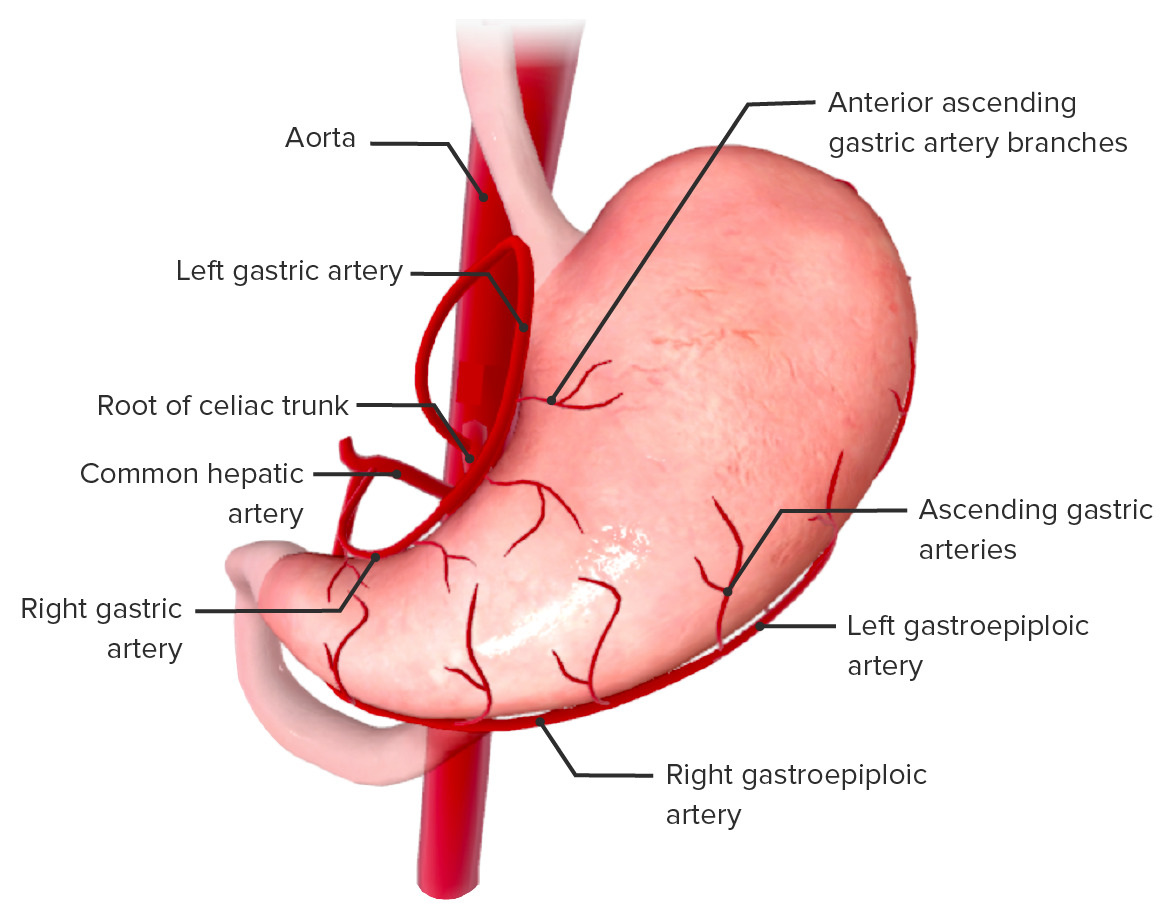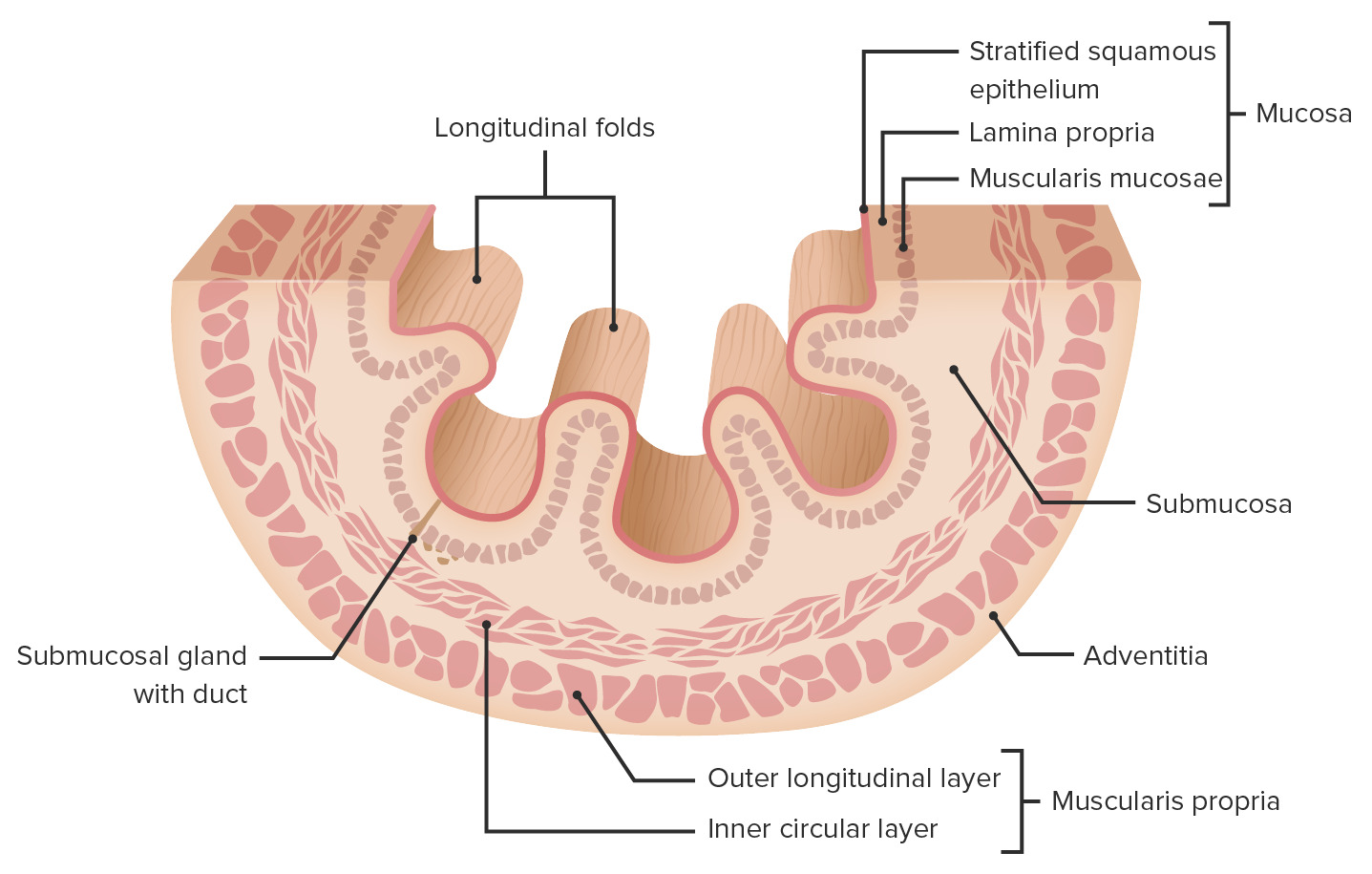Playlist
Show Playlist
Hide Playlist
Anatomy of the Stomach
-
Slides Anatomy of the Stomach.pdf
-
Download Lecture Overview
00:01 So now let's have a look at the actual stomach itself. We've concentrated on the esophagus, so now let's have a look at the stomach. The stomach is a strange-looking organ. It's very much like a bag which is being filled with food that's passing down from the esophagus and you can see actually the bit that's projecting above the esophagus is known as the fundus. This is often filled with air. And then the region immediately at the entrance of the esophagus is the cardia region, which you can see there. Here, we then have the main substantial part of the stomach which is the body. We then have an indentation and a region known as the lesser curvature. This is known as the angular incisure. And that separates the body from the pyloric antrum, which you can see there. 00:45 The pyloric antrum then tapers into the pyloric canal which will eventually go on to form the duodenum. 00:50 So there are some K-line marks there on this anterior surface of the stomach. We also have this short edge of the stomach which is going from the esophagus all the way through to the pyloric region. That's the lesser curvature. And then we have a much greater curvature, which is taking this longer course around this perimeter aspect of the stomach. You can see that on the greater curvature there. Here, we can see the indentation between the esophagus and the fundus of the stomach around the greater curvature where it starts and that is known as the cardiac notch. If we were to look at the anterior surface of the stomach, there's a slightly different tilt on here. We can actually see here is the anterior surface, that it has some relationships with various organs and other structures in the region. So here on the lateral aspect of the stomach we can see where it comes into contact with the diaphragm. Here is where the left lobe of the liver touches on to its more medial surface. 01:47 And here we can see it has a connection with the anterior abdominal wall. So the stomach is quite superficial and it's touching the anterior surface of the abdomen. It's also touching the diaphragm and it has a connection with the left lobe of the liver. 02:01 If we were to spin the stomach right to look at its posterior surface, then actually its contact with lots of other organs as well. We'll come to how it's related to the transverse colon in a moment. The transverse colon is part of the large intestine. We can see that's associated with the greater curvature of the stomach. It's associated with the spleen and important blood vessel runs along the posterior stomach body. This also supplies the spleen, the splenic artery. We also have the pancreas that runs alongside it as well. We have various kidneys, adrenal gland, all associates it with the stomach posterior aspect. So the fact that you've got lots of these structures sitting and touching its posterior surface does let you know that the stomach is relatively anterior within the abdomen. And by moving the stomach away, lifting the stomach up, moving it to the side, you will reveal structures that lie underneath. So let's have a look at the surface of the stomach. The inner surface of the stomach is highly rough. 03:01 It's got lots and lots of elevations, there's lots of contours within the inner surface of the stomach and that helps it to expand and change in size as we ingest food. It also helps to increase the surface area which is important. But what we can see if we go back to that region where the esophagus joined the stomach. 03:20 We can see we have this cardiac orifice. This opening between the esophagus and the stomach. And here we have a Z line and that really demarcates some histological differences between the esophagus and the stomach as a whole. So we can see the esophagus is now entering into the stomach. 03:39 Again, looking at the stomach, you can see its wall, we've got these gastric folds or rugae. And these are those undulations giving increased surface area to the stomach helping it to expand with size but also increasing its surface area. As we have a look at the outer wall and various aspects of the stomach, you can see just running along the lesser curvature we have these longitudinal folds of gastric canals and they help to channel food down towards the pylorus. So once the stomach is churned, they help food to pass in the right direction down to the pylorus. Here, we're specifically looking at the pyloric sphincter. So this is the very end of the stomach. So food is entered, chew in, esophagus, is passed into the stomach whereas digestive processes have occurred and then the food is channelled all the way down to this pyloric sphincter. Now this is a very hot anatomical sphincter. It has specializations of circular muscle, meaning is under constant control and regulation. So where food can naturally flow from the esophagus into the stomach, there's more of a physiological sphincter. Here, guarding the stomach from the duodenum we have a pyloric sphincter and that has clearly lots of circular muscle that helps to regulate the flow of food from the stomach into the duodenum.
About the Lecture
The lecture Anatomy of the Stomach by James Pickering, PhD is from the course Anatomy of the Esophagus and Stomach.
Included Quiz Questions
Which enzyme is released by the chief cells of the stomach?
- Pepsinogen
- Trypsinogen
- Chymotrypsinogen
- Amylase
- Glucagon
While studying a normal X-ray film, a medical student notices a gas-filled area on the left side of the film. Which structure is it most likely to be?
- Fundus of the stomach
- Heart
- Esophagus
- Duodenum
- Pylorus
Which area of the stomach is attached to the liver via a peritoneal fold?
- Lesser curvature
- Greater curvature
- Cardiac orifice
- Fundus
- Body
Customer reviews
5,0 of 5 stars
| 5 Stars |
|
5 |
| 4 Stars |
|
0 |
| 3 Stars |
|
0 |
| 2 Stars |
|
0 |
| 1 Star |
|
0 |





